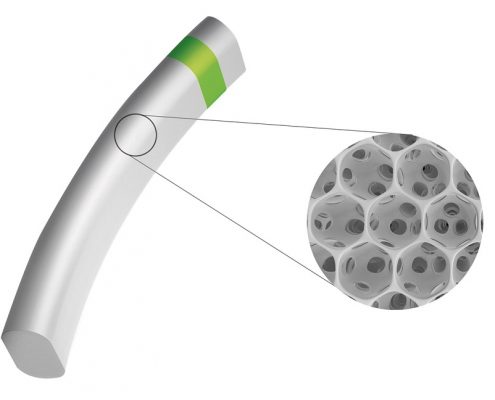iSTAR Medical, a medtech company pioneering novel minimally-invasive implants for glaucoma surgery (MIGS), today announced the final results of the STAR-II European trial for its MIGS device, MINIjectTM. These data show consistently outstanding performance and a favorable safety profile in patients with primary open-angle glaucoma up to two years of follow-up. The trial results will be presented at the 125th American Academy of Ophthalmology (AAO) meeting in New Orleans, LA (USA), from 12 to 15 November 2021.
Two-year results from STAR-II
The two-year results from the MINIject STAR-II European trial indicated sustained, powerful efficacy and favorable safety outcomes in patients with primary open-angle glaucoma. Consistent with all MINIject trial outcomes to date, mean intraocular pressure (IOP) was remarkably reduced by 36% from 24.6mmHg at baseline to 15.5mmHg at two-year follow-up, with a 52% reduction in glaucoma medication use from 2.9 at baseline to 1.4 at trial completion. Furthermore, corneal health results in this study were outstanding, which is of pivotal importance for long-term safety.[1],[2],[3]
“The remarkable outcomes observed throughout the European trial keep adding to a significant body of evidence showing how MINIject offers a powerful, bleb-free option for the treatment of patients with primary open-angle glaucoma,” said Dr I. Paul Singh, The Eye Centres of Racine & Kenosha, WI (USA), who is presenting the trial results at AAO. “This may enable more effective glaucoma management and better quality of life for patients that need lower IOP and who are uncontrolled or struggling to comply with multiple medications.”
In the STAR-II trial, 29 patients with open-angle glaucoma were implanted with MINIject across eight centres in Germany, France and Spain. These patients were followed for two years post-intervention.
Three-year data from STAR-GLOBAL
In addition, interim data from the STAR-GLOBAL trial indicate that MINIject’s sustained efficacy and safety results, including the limited need for reoperations, have now been maintained for up to three years, with favourable results for corneal health.
“These preliminary longer-term data on MINIject are particularly encouraging, as they show a very solid sustained performance and safety profile, which are consistent throughout this trial so far and across all trials with the device to date,” said Dr Steven Vold, Vold Vision, Fayetteville, AR (USA) who is presenting the STAR-GLOBAL data at AAO.
STAR-GLOBAL is a prospective, long-term follow-up trial, which enrolls patients already implanted with MINIject and followed for two years as part of previous STAR trials, to evaluate long-term efficacy and safety up to five years.
MINIject leverages the advantages of the supraciliary space
Unlike MIGS devices commercially available, MINIject is implanted into the supraciliary space, a natural fluid-drainage pathway for powerful reduction of eye pressure. Unlike previous supraciliary MIGS devices, MINIject has not seen issues with scarring around the implant (fibrosis) nor substantial reductions of corneal cell health.1,2,3,[4],[5]
“The antifibrotic properties and flexible structure of the MINIject porous proprietary STAR material are enabling a safe use of the supraciliary space while unlocking unprecedented MIGS results in patients with glaucoma. These results indicate a balance of sustained efficacy and favourable safety, and may conclusively demonstrate in time that MINIject outperforms alternative MIGS options,” said iSTAR Medical CEO, Michel Vanbrabant.
The STAR-II and STAR-GLOBAL outcomes will be available as on-demand posters throughout the AAO meeting, starting from Friday 12 November.
[1] Lass, J.H., Benetz, B.A., He, J., et al. Corneal Endothelial Cell Loss and Morphometric Changes 5 Years after Phacoemulsification with or without CyPass Micro-Stent. Am J Ophthalmol, 2019; 208: 211–218, doi: 10.1016/j/ajo.2019.07.016.
[2] HORIZON data submitted to FDA: https://www.accessdata.fda.gov/cdrh_docs/pdf17/P170034B.pdf
[3] iStent inject data submitted to FDA: https://www.accessdata.fda.gov/cdrh_docs/pdf17/P170043B.pdf
[4] Grierson, I., Minckler, D., Rippy, M.K., et al. A novel suprachoroidal microinvasive glaucoma implant: in vivo biocompatibility and biointegration. BMC Biomed Eng, 2020; 2, 10, doi: 10.1186/s42490-020-00045-1.
[5] Denis, P., Hirneiß, C., Durr, G.M., et al. Two-year outcomes of the MINIject drainage system for uncontrolled glaucoma from the STAR-I first-in-human trial. Br J Ophthalmol. 2020; 0:1–6, doi: 10.1136/bjophthalmol-2020-316888
[6] Market Scope, “Glaucoma Surgical Device Market Report”, August 2020. https://www.market-scope.com/pages/reports/202/2020-glaucoma-surgical-device-market-report-a-global-analysis-for-2019-to-2025-august-2020
[7] Jonas JB, Aung T, Bourne RR et al. “Glaucoma”. Lancet 2017; 390: 2083–93
[8] European Glaucoma Society, “Terminology and Guidelines for Glaucoma”, 4th Edition: B J Ophthalmol. 2017; 101:1-195, doi: 10.1136/bjophthalmol-2016-EGSguideline.002
